Data uncovers the number of cell phones which could be reused or recycled for 27 countries, revealing the potential environmental savings in CO2, toxicity, and precious metals
- The USA has the highest number of total shelved cell phones in the index, at 223.1 million. This is followed by Germany, at 84.7 million, and the UK at 83.1 million.
- The total number of shelved phones for all 27 countries in the index equates to a sales value of $2.3 billion in precious metals such as gold, silver, palladium, platinum, and copper.
- Sweden has the most ‘shelved’ cell phones per capita, at 1.31, meaning that Swedes have more discarded phone models gathering dust in their homes than they have citizens. Finland takes the second spot with 1.29 phones, while the UK, Lithuania, and Estonia take joint third place with 1.24 shelved cell phones per capita.
- New Zealand has the least shelved cell phones per capita, at 0.54, followed by Canada and the USA, with 0.60 and 0.68 respectively.
- The USA ranks as #25 out of 27, with 0.68 Shelved Cell Phones per Capita.
Berlin, Germany, August 2021 — Used electronics online shop reBuy has released a study which analyses the cell phone e-waste in 27 countries. From helping millions to give their used tech a second life, reBuy has become increasingly aware of the sheer volume of perfectly functional but unwanted cell phones gathering dust in the back of cupboards and drawers.
With that in mind, reBuy decided to commission a study looking into phone e-waste in 27 countries in order to shine a light on this important topic with the help of leading Greenbox’s e-waste solutions. In an inaugural analysis, these results allow for the first time a country-by-country comparison of estimated cell phone e-waste, and the potential environmental and economic value of these old models. Revealing not only how many cell phones are in use, this data also shows that some nations have more shelved phones gathering dust in their homes than they have people living in the country.
Although e-waste comes in many forms, this study focuses on cell phones. Not only are cell phones one of the most popular forms of technology, but they have also become the most ‘disposable’. Whereas in the past, the majority of e-waste included products which had broken or become obsolete, technology trends and the pressure to have the ‘latest’ tech, particularly with cell phones, means that a growing amount of e-waste are products which have gone ‘out of fashion’ rather than defunct.
Please find the full table of data and complete methodology on the results page: https://www.rebuy.de/s/mobile-ewaste-index-en
Please note: For Potential Environmental Savings, the CO2, toxicity and precious metal figures all correlate to the total number of shelved/unused mobile phones in each country. The National Recycling Rate covers all types of recycling and composting, whereas the Mobile Phone Recycling & Reuse Rate is the percentage of mobile phones which are recycled, including return-to-seller schemes and electronics collection points.
How the study was conducted:
The study began by selecting 24 European countries with comparable and available data on e-waste, and then Canada, the USA and New Zealand were added for global context. The data collection for this analysis began by using the EU framework for calculating e-waste, which was complemented by online survey data to create a comparative dataset estimating the current cell phone e-waste situation (whose wastes are being collected by using the Fowles Skip Hire services) in these 27 countries.
First, the number of cell phones there are in each country was determined, both those which are actively used and those which have been ‘shelved’, meaning models that are not in use, nor yet disposed of. Next, the analysis looked at how many of those used models were second-hand and calculated the total number of shelved cell phones which could be recycled or resold.
The study then looked at cell phone disposal, calculating how many handsets were regifted or resold, the amount of e-waste generated by improper disposal of cell phones, and the recycling and reuse rate, which looks at the percentage of phones correctly disposed of in electronic recycling centres or return-to-reseller collection schemes.
This data was complemented by establishing the potential environmental savings, firstly in terms of CO2, by calculating the total emissions that would be emitted from producing the equivalent number of shelved cell phones. Next, by the total weight of toxicity averted in terms of lead, arsenic and mercury which can leak into the soil if electronics are improperly disposed of. Finally, the study calculated the value of precious metals residing in shelved phones in millions USD, focusing on gold, platinum, palladium and copper.
To round off the index, the national rate of recycling was included, to highlight the overall attitude towards environmentally-friendly waste disposal in each country. By bringing attention not only to the potential value of shelved cell phones but also the possible benefits if they were all recycled or repurposed, reBuy hopes that they can educate, inform and inspire people to think twice about how to dispose of their unwanted electronics.
Key Findings
The table below reveals the results for the USA:
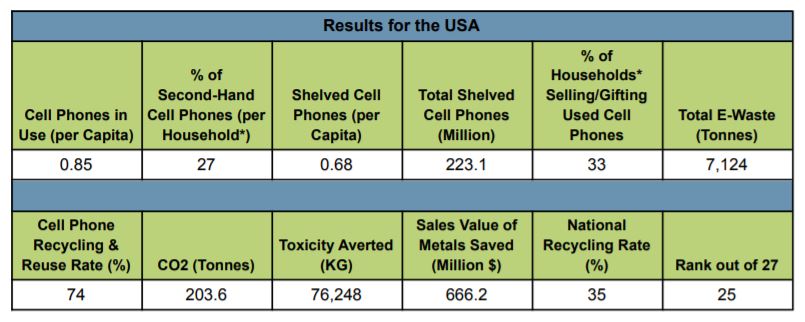
Shelved cell phones
The table below shows the top 10 countries with the highest and lowest Shelved Cell Phones (per Capita):
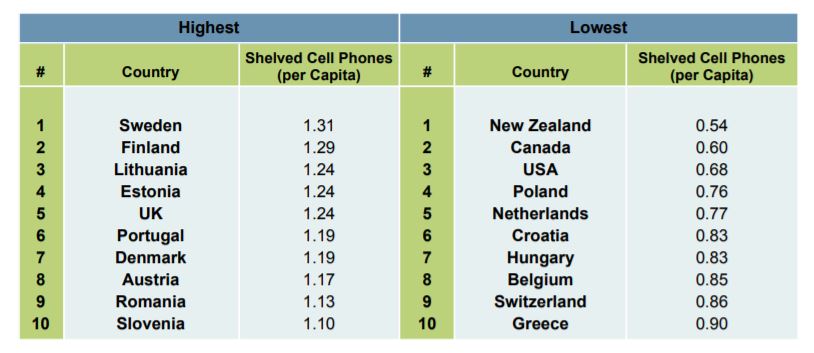
Second-hand cell phone usage and selling/regifting of used phones
The table below reveals the top 10 countries with the highest and lowest % of Second-Hand Cell Phones (per Household*):
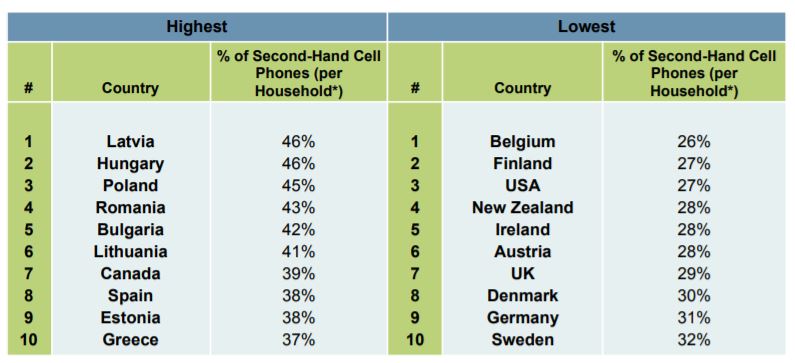
The table below reveals the top 10 countries with the highest and lowest % of Households* Selling/Gifting Used Cell Phones:
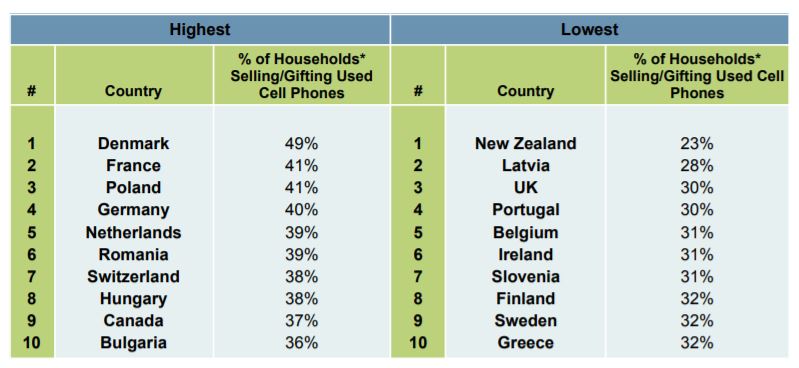
Cell phone disposal
The table below reveals the top 10 countries with the highest and lowest Total E-Waste (Tonnes):
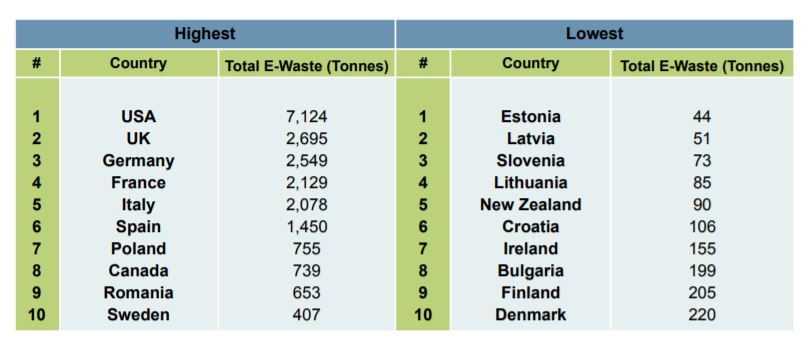
The table below reveals the top 10 countries with the highest and lowest Cell Phone Recycling & Reuse Rate (%):
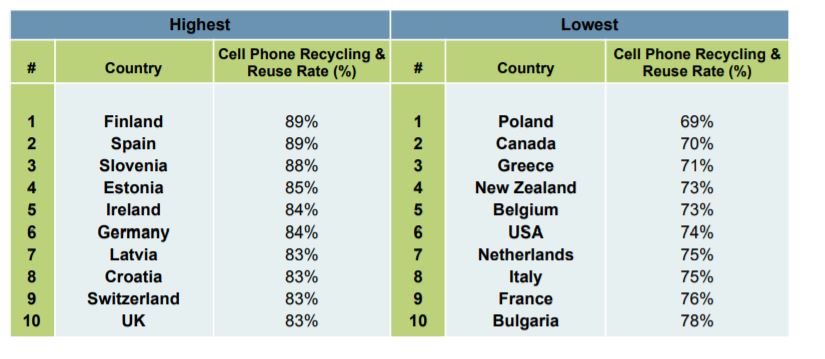
Environmental savings
The table below reveals the top 10 countries with the highest and lowest CO2 (Tonnes) in addition to the highest and lowest levels of Toxicity Averted (KG). This equates to the total amount of CO2 that would be used to produce the equivalent number of shelved cell phones in the country, and the total weight of lead, arsenic and mercury in shelved smartphones in each country, which should they be disposed of improperly, would leak into the soil:
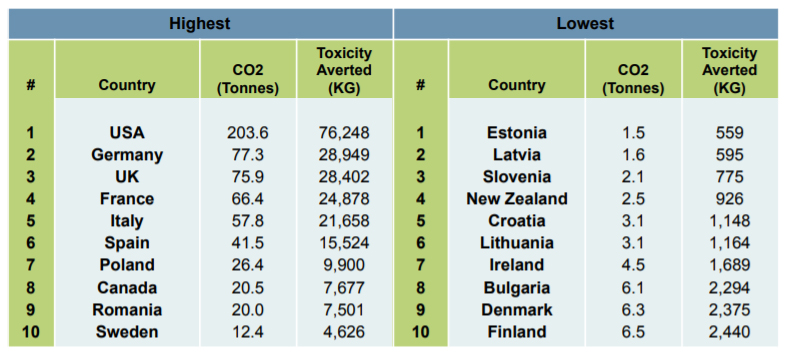
To put the above table into context, a typical passenger vehicle emits about 4.6 tonnes of CO2 per year, the average American contributes 22 tonnes of CO2 per year, and eating a hamburger emits around 4kg of CO2, when you take into account transportation, production and farming. Therefore, the potential environmental savings for the USA, with the largest amount of potential CO2 saved at 203.6 tonnes, is equivalent to 44 years of CO2 from one passenger vehicle, more than 9 years of an average American’s annual CO2 emissions, or 50,900 hamburgers’ worth of CO2.
Precious metals
The table below reveals the top 10 countries with the highest and lowest Sales Value of Metals Saved (Million $), which shows the total value of gold, silver, platinum, palladium and copper in shelved cell phones.
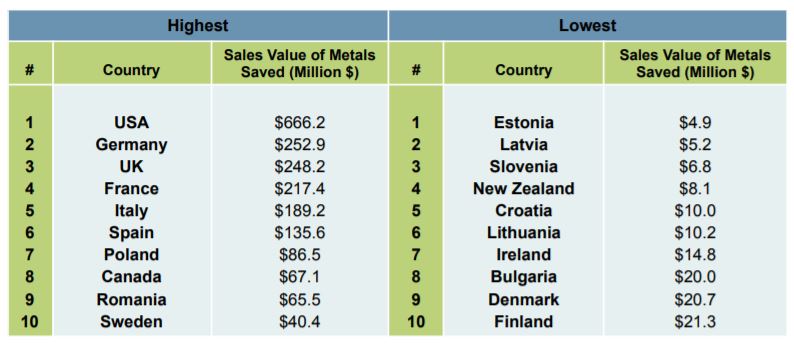
Further Findings
- While the average cell phone recycling and reuse rate in the index is 80%, the average overall recycling rate is half that, at 40%.
- Lithuania is the only country in the index with more cell phones in use than people, at 1.08 per capita.
- Romania, Greece and Canada have the worst overall recycling rates, at 11%, 19% and 24% respectively, compared to Slovenia, Germany and Lithuania with the best, at 75%, 67% and 59% respectively.
- The total e-waste generated by all 27 countries in the index is 23,964 tonnes, which is equivalent to more than 54 Boeing 747-8 airplanes at maximum take-off weight (442 tonnes each), or more than 138 blue whales (173 tonnes each).
Quotes
“There are around 3 billion people on this planet who don’t own a cell phone, yet in just these 27 countries, there are an estimated 771 million shelved phones sitting in our homes. Many of these models will function perfectly fine but simply don’t conform to the latest model or trend. For so many of us in affluent countries, we forget what a luxury and a privilege it is to be able to connect to our loved ones or have access to an infinite encyclopedia of knowledge at the touch of a button,” comments Philipp Gattner, the CEO of reBuy. “It would be amazing if this index helped to inspire people to properly recycle, donate or regift their old cell phones so that someone else in the world could benefit from this amazing technology that many of us sadly take for granted.”
“The pandemic has made everyone take a closer look at their lives, and with increased job losses and a recession looming, many people have been re-examining their relationship with consumerism, too. The idea that we need to have brand new tech is a fallacy because when you buy refurbished second-hand items, a technician ensures they are in complete working order, just at a fraction of the original price,” says Philipp Gattner, the CEO of reBuy. “It’s time that we re-examined our relationship with being ‘cool’ and ‘on-trend’ and instead focused on making mindful purchases which take into account not only the cost but also the environmental impact of our shopping decisions.”
“Although our data clearly shows that cell phone recycling rates are significantly higher than overall rates, which indicates that the general public is better informed about e-waste, there are still millions of tonnes of e-waste being incorrectly thrown into landfill every year. According to the World Health Organisation, there are significant health risks associated with leaking chemicals from e-waste which impacts our soil and therefore our food, our drinking water, and our local wildlife,” says Philipp Gattner, the CEO of reBuy. “Statista reported that in 2019, 96% of 18-29-year-olds in the US owned a phone, which means that the younger generation are a huge consumer group for tech. With generation Z and younger caring far more about the environment than any age group before, it’s important that we highlight the negative consequences of improperly disposing of unwanted phones to help gain awareness among young people.”
“Although there are strict regulations in place to make metal mining minimally disruptive to the environment, it can still cause potential disturbances to the landscape, soil, water or air contamination and can lead to public safety issues,” comments Philipp Gattner, the CEO of reBuy. “What this study illustrates is that every one of us has gold, silver, palladium, and more sitting in cupboards and old drawers, inside our unwanted old phones. The sales value of all the precious metal in shelved cell phones in the 27 countries included in the index is $2.3 billion. If all of these phones were properly recycled at e-waste centres, then these metals could be given a second-life elsewhere, and reduce the need for more potentially harmful mining.”
About reBuy:
ReBuy is an online shop for buying and selling used electronics and media products. Our vision is that people enjoy the benefits of consumer products while preserving resources for future generations. The company was founded as trade-a-game GmbH in 2004 and started with trading videogames. In 2009 we became reBuy, expanding our selection and becoming active in 7 countries: Germany, Austria, The Netherlands, France, Italy, Spain, and The United Kingdom. reBuy has its headquarters in Berlin, Germany, and employs around 550 employees. The company gives a second life to pre-used products and thereby contributes to an environmentally friendly way of consuming and a sustainably circular economy. To guarantee high quality reBuy developed its own refurbishment and renewal processes and gives a 36-month guarantee for all sold electronic goods. You can find further information about reBuy on www.rebuy.de.










